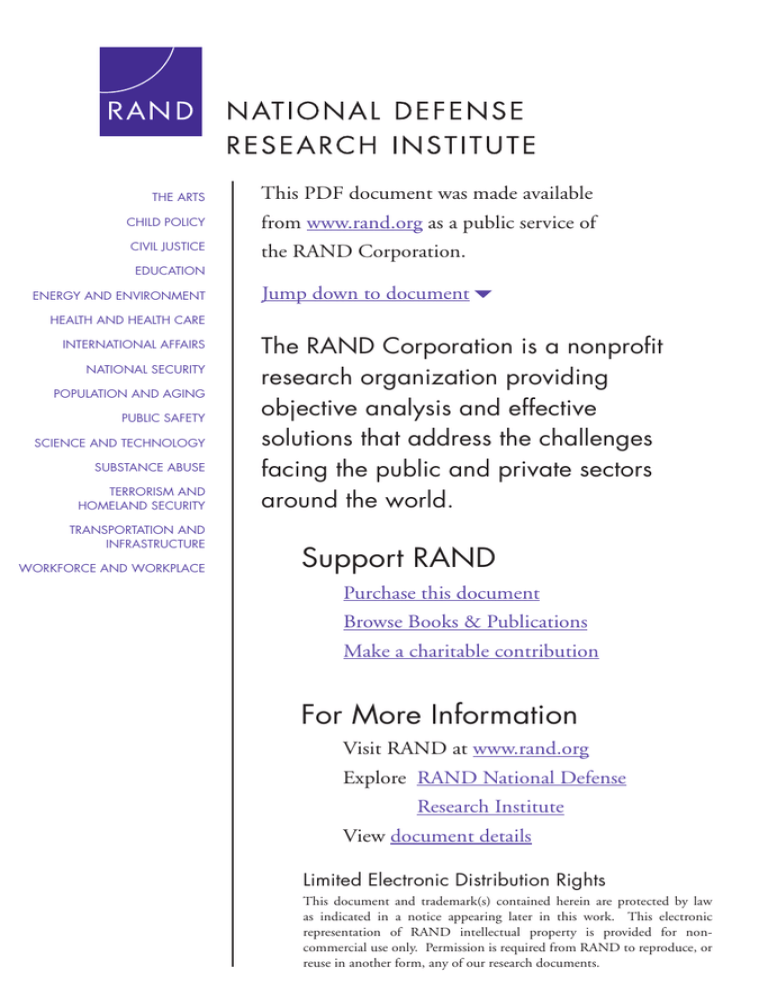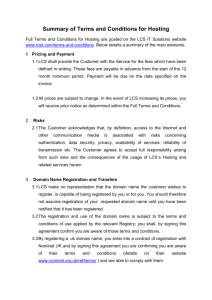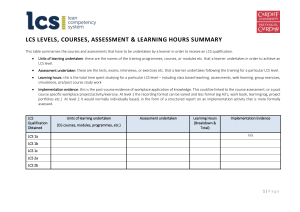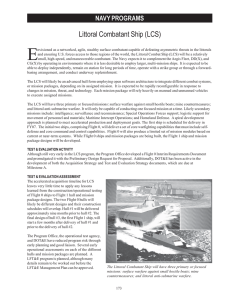
THE ARTS
This PDF document was made available
CHILD POLICY
from www.rand.org as a public service of
CIVIL JUSTICE
the RAND Corporation.
EDUCATION
ENERGY AND ENVIRONMENT
Jump down to document6
HEALTH AND HEALTH CARE
INTERNATIONAL AFFAIRS
NATIONAL SECURITY
POPULATION AND AGING
PUBLIC SAFETY
SCIENCE AND TECHNOLOGY
SUBSTANCE ABUSE
TERRORISM AND
HOMELAND SECURITY
TRANSPORTATION AND
INFRASTRUCTURE
WORKFORCE AND WORKPLACE
The RAND Corporation is a nonprofit
research organization providing
objective analysis and effective
solutions that address the challenges
facing the public and private sectors
around the world.
Support RAND
Purchase this document
Browse Books & Publications
Make a charitable contribution
For More Information
Visit RAND at www.rand.org
Explore RAND National Defense
Research Institute
View document details
Limited Electronic Distribution Rights
This document and trademark(s) contained herein are protected by law
as indicated in a notice appearing later in this work. This electronic
representation of RAND intellectual property is provided for noncommercial use only. Permission is required from RAND to reproduce, or
reuse in another form, any of our research documents.
This product is part of the RAND Corporation monograph series.
RAND monographs present major research findings that address the
challenges facing the public and private sectors. All RAND monographs undergo rigorous peer review to ensure high standards for
research quality and objectivity.
Littoral Combat
Ships
Relating Performance
to Mission Package Inventories,
Homeports, and Installation Sites
Brien Alkire • John Birkler • Lisa Dolan • James Dryden
Bryce Mason • Gordon T. Lee • John F. Schank • Michael Hayes
Prepared for the
United States Navy
Approved for public release;
distribution unlimited
NATIONAL DEFENSE RESEARCH INSTITUTE
The research described in this report was prepared for the United States
Navy. The research was conducted in the RAND National Defense
Research Institute, a federally funded research and development center
sponsored by the Office of the Secretary of Defense, the Joint Staff,
the Unified Combatant Commands, the Department of the Navy,
the Marine Corps, the defense agencies, and the defense Intelligence
Community under Contract W74V8H-06-C-0002.
Library of Congress Cataloging-in-Publication Data is available for this publication.
ISBN 978-0-8330-4146-3
The RAND Corporation is a nonprofit research organization providing
objective analysis and effective solutions that address the challenges
facing the public and private sectors around the world. R AND’s
publications do not necessarily reflect the opinions of its research clients
and sponsors.
R® is a registered trademark.
Cover Design by Stephen Bloodsworth
© Copyright 2007 RAND Corporation
All rights reserved. No part of this book may be reproduced in any
form by any electronic or mechanical means (including photocopying,
recording, or information storage and retrieval) without permission in
writing from RAND.
Published 2007 by the RAND Corporation
1776 Main Street, P.O. Box 2138, Santa Monica, CA 90407-2138
1200 South Hayes Street, Arlington, VA 22202-5050
4570 Fifth Avenue, Suite 600, Pittsburgh, PA 15213-2665
RAND URL: http://www.rand.org/
To order RAND documents or to obtain additional information, contact
Distribution Services: Telephone: (310) 451-7002;
Fax: (310) 451-6915; Email: order@rand.org
Summary
In June 2005, workers at the Marinette Marine shipyard in Marinette,
Wisconsin, laid the keel for the USS Freedom, the Navy’s first Littoral
Combat Ship.1 The LCS constitutes a new class of fast, agile, and networked warships designed to overcome threats in shallow waters posed
by mines, diesel-electric submarines, fast-attack craft, and fast inshore
attack craft.
LCSs will be key components in a proposed family of nextgeneration surface combatants that also includes the much larger
DDG-1000 destroyer and a future CG(X) cruiser.2 LCSs will be able
to deploy independently to overseas littoral regions; remain on station
for extended periods of time, either with a carrier strike group or an
expeditionary strike group or through a forward-basing arrangement;
operate independently and/or with other LCS units; and be replenished while under way.
LCSs: Transformational Capabilities and Modular Mission
Packages
LCSs will bring an array of transformational capabilities to the Navy.
Able to achieve speeds of 40 to 50 knots and maneuver in waters less
than 20 feet deep, LCSs will operate in environments where employ1
The Freedom’s keel was laid and authenticated on June 2, 2005 (“Keel Laid,” 2005).
2
The DDG-1000 was formerly named DD(X). See Fein, 2006. In addition, there is also
considerable interest in LCS modules for future U.S. Coast Guard applications as part of the
service’s Integrated Deepwater System.
xvii
xviii
Littoral Combat Ships
ing larger, multimission ships would be infeasible or ill-advised. They
will be networked into the fleet, operating as part of a distributed force;
sharing tactical information with other Navy aircraft, ships, submarines, and joint units; and launching manned and unmanned vehicles to execute missions. They will incorporate advanced technologies,
employing cost optimized advanced weapons; sensors; data fusion;
command, control, communications, computers, intelligence, surveillance, and reconnaissance (C4ISR) systems; hull forms; propulsion systems; manning concepts; smart control systems; and self-defense systems (U.S. Navy Littoral Combat Ship Web site, not dated).
But perhaps the most transformational features of LCSs will be
their modular capabilities. Plans call for Freedom and each subsequent
LCS to consist of two elements:
• a core seaframe that includes the ship platform and inherent combatant capabilities. Each seaframe will be able to perform a set
of primary functions—including self-defense, navigation, C4I,
and launching and retrieving unmanned vehicles—that will be
common to all missions.
• a set of interchangeable modular “plug-and-fight” mission packages that will allow the ship to be reconfigured, as needed, for
antisubmarine warfare (ASW), mine warfare (MIW), or surface
warfare (SUW) missions. A mission package may consist of a
combination of mission modules, such as manned and unmanned
vehicles, deployable sensors, and mission manning detachments.
The components of a mission module predominantly fit inside
several standard-size 20-foot cargo containers.3 The mission modules will integrate into the seaframe, and any LCS can hold any
mission package.4 An LCS can be reconfigured with a new mission package in a few days while laying pier side.
3
Standard 20-foot cargo containers measure 20 feet in length, 8 feet in width, and 8.5 feet
in height. A standardized form factor is designed to allow them to be loaded on ships, trucks,
and railroad cars.
4
Our study assumed that all seaframes could operate with all mission packages, which was
consistent with U.S. Navy planning at the time of the study. However, it is probable that
Summary
xix
At the time of the study, Navy plans included acquisition of one
seaframe in fiscal year (FY) 2005, an additional seaframe in FY 2006,
two seaframes in FY 2007, and three in FY 2008, after which the
Navy would begin acquiring five a year.5 At that pace, the short-term
inventory of seaframes could reach 36 by FY 2014, the middle-term
inventory of seaframes could reach 60 by FY 2019, and the long-term
inventory of seaframes could reach 84 by FY 2024.
Issues We Addressed
In early 2005, RAND was commissioned by the LCS Program Office6
to help it think through the cost and logistics implications of modular
mission packages planned for the LCSs. In particular, the LCS Program Office was interested in gaining a clearer understanding of operational, logistics, and cost trade-offs between three interdependent elements of the program: the number of LCSs in the fleet, the number of
mission packages7 that those LCSs would require to perform a range of
missions, and the number of and the locations of LCS homeports and
mission package installation sites.
Methods and Data We Used
RAND analyzed these issues between January and November 2005,
employing both qualitative and quantitative methodologies to examine
there will be upgrades and modernization efforts that may pose challenges for maintaining
compatibility.
5
After the conclusion of the study, the Quadrennial Defense Review recommended an
increase in the Navy’s annual procurement of LCSs. Francis, 2006, indicates up to six ships
per year from 2009 through 2011, for a total of 55 through 2029. See also Cava, 2006.
6
7
The official name of our sponsor is PMS 501, LCS Program Office.
Aviation assets were assumed to be collocated with other mission package components
for the purposes of this analysis. The scope of this project did not allow for evaluation of the
number of aviation assets separately from mission packages.
xx
Littoral Combat Ships
the LCS fleet at three discrete points in the future: the short term (by
2014), middle term (by 2019), and long term (by 2024).
Qualitative Analyses: Scenarios and LCS Employment Options
To gain an understanding of what the LCS fleet might encounter over
the short, middle, and long term, we examined the LCS concept of
operations (LCS CONOPS) (U.S. Navy, 2004) in conjunction with
the strategic environment laid out in the 2005 National Defense Strategy and amplified in various U.S. Navy documents (U.S. Navy, 2003
and 2005).8 This research led to various scenarios in which the ships
might be expected to play a part through 2024. Every scenario that we
evaluated involved a simultaneous operation from each of the following four categories:
• Major Combat Operations (MCOs)—for example, responding to a
crisis in the Western Pacific, Southwest Asia, or Northeast Asia.
• Global War on Terrorism Operations—for example, responding to
a chemical weapons attack on UN forces, clearing mines laid by
terrorists in sea lanes, or eliminating terrorist training camps.
• Stability Operations—for example, providing humanitarian assistance and disaster relief, supporting a friendly government against
insurgents, providing maritime security for oil platforms, providing forward presence and maritime interdiction operations in the
vicinity of shipping lanes, or participating in ASW exercises/submarine tracking.
• Homeland Defense Operations—for example, providing security
and humanitarian assistance/disaster relief following terrorist
attacks on U.S. seaports, providing security and humanitarian
assistance/disaster relief following a natural disaster along the
U.S. seaboard, or providing humanitarian assistance following a
refugee crisis in the Caribbean.
8
Our specific terms mirror “The Evolving Strategic Environment” as shown in Figure 1 of
U.S. Navy, 2005.
Summary
xxi
We also examined how the Navy plans to use LCSs. The LCS
CONOPS describes plans for the Navy to embed LCSs in carrier strike
groups or expeditionary strike groups, to deploy them independently,
or to operate them as forward deployed units. Using these deployment concepts and potential threat characteristics, we evaluated ways
in which the Navy might employ LCSs in the context of each scenario. This allowed us to develop baseline LCS requirements, including expected modes of employment, operating locations, and mission
tasking.
Quantitative Analyses: Transit, Logistics, and Cost Modeling
Once we had analyzed the scenarios that LCS might encounter and the
ways that the Navy plans to use the vessels, we turned to our quantitative analyses. As a first step, we derived measures of effectiveness for
the LCS. Because a key capability of the LCS is its ability to respond
quickly to a crisis, we used the time required for all LCSs to close on
the theaters of operation as our principal measure of effectiveness—
we term this metric “total closure time.”9 We also derived other metrics—the number of LCS days spent in the littoral region of an area of
operation in advance of a strike group, the time it takes for each LCS
to arrive on station, the time it takes for each strike group to arrive
on station, the number of mission package reconfigurations by type
and geographic location, and the number of refueling-at-sea operations
required by each LCS to reach theaters of operation.
Once we had derived metrics, we developed a series of analytical tools to evaluate them. These tools allowed us to make trade-offs
among different numbers of mission packages for the proposed number
of LCSs and the locations of LCS homeports and mission package
installation sites.10
The main analytical tool that we developed was a model that we
called the LCS Transshipment Model (LCSTSM). Derived from a
9
Our analytical framework allows prioritization of closure time for LCSs in different operations; we treated them all with equal priority for this study rather than making assumptions
on the future priorities of government decisionmakers.
10
We assume that homeports include a mission package installation site.
xxii
Littoral Combat Ships
well-known class of transshipment models, the LCSTSM enabled us
to depict how the LCS would perform under a variety of assumptions.
Other models that we developed allowed us to estimate the costs of
procuring seaframes and mission packages and of constructing LCS
homeports and installation site facilities.
Using the LCSTSM, we varied operational and logistics elements
of the LCS, including
•
•
•
•
the number of seaframes
the number of mission packages
the locations of homeports
the locations of installation sites.
We then ran multiple computer simulations with randomly
selected scenarios, locations from which LCSs would start their missions, and differing availability of assets. These simulations yielded the
metrics. We examined how the average values of those metrics were
affected by varying the operational and logistical elements. This information allowed us to identify the optimal locations for homeports and
installation sites and the optimal sizes for mission package inventories.
We then used our cost models to estimate annual and total costs to
procure those mission package inventories and construct homeports
and installation sites.
Preferred Homeports and Installation Sites
We analyzed 15 locations around the world as potential LCS homeports or installation sites.11 Using the LCSTSM, we tested those locations across a range of scenarios and mission package inventories to
determine the sites that LCSs would most frequently visit to install or
swap mission packages in the short, middle, and long term.
11
Bahrain; Darwin and Fremantle, Australia; Diego Garcia; Guam; Japan; Mayport, Norfolk, Pascagoula, San Diego, and Hawaii in the United States; the western and eastern Mediterranean; Puerto Rico; and Singapore. We assume that an LCS homeport includes a mission
package installation site.
Summary
xxiii
We found that 3 of the 15 locations were best supported as homeports by our analysis in all three time frames—Norfolk, San Diego,
and Japan—and two as mission package installation sites—Singapore
and Bahrain.12
Preferred LCS Mission Package Inventories
We used the three preferred locations for LCS homeports and the two
preferred locations for installation sites to help calculate the best LCS
mission package inventories in the short, medium, and long term. We
employed a three-step process to make this calculation. For each time
frame, we
• evaluated the average proportion of each LCS mission package
type that the Navy would need to meet scenario demands
• estimated the minimum number of each LCS mission package
type that the Navy needs to optimize total closure time
• determined the quantities of each LCS mission package type that
the Navy will need at each preferred location.
The results of this mission package inventory analysis are summarized in Table S.1, which shows the number of ASW, MIW, and
SUW missions package inventories identified by our analysis for each
time period.
Summing the mission package quantities listed in Table S.1 by
type, we see that our analysis suggests the Navy will need a total of 89
mission packages in the short term, 104 in the middle term, and 126 in
the long term to meet scenario needs with minimal closure time across
the LCS fleet.
12
The political sensitivities and space limitations for an installation site in Bahrain may be
more significant than anticipated during the course of our study. A reexamination of this
prospect was outside the scope of our charter. However, we would hypothesize that a location
in the eastern or central Mediterranean might provide a suitable alternative. This hypothesis
is supported by excursions discussed in this monograph, but it should be examined more
carefully.
xxiv
Littoral Combat Ships
Table S.1
Mission Package Inventories in the Short Term, Middle
Term, and Long Term
Time Period
ASW
MIW
SUW
Short term (by 2014)
20
27
42
Middle term (by 2019)
23
31
50
Long term (by 2024)
28
38
60
NOTES: Inventory levels depend on the operational availability,
which is defined as the fraction of time that mission packages
are available for mission use. Operational availability estimates
for mission packages were not available at the time of this
study. The inventory levels in this table assume that the
operational availability of mission packages is 0.9. The numbers
will need to be adjusted for different estimates of operational
availability. For instance, if the operational availability is
estimated to be x, then each number in the table should be
multiplied by 0.9/x.
Preferred LCS Mission Package Storage Locations
Our analysis also identified the number of mission packages in inventory to be stored on available seaframes, at each homeport, and at each
installation site in each time period. Table S.2 lists the inventories by
location for the short term, Table S.3 for the middle term, and Table
S.4 for the long term.
Total Procurement Cost for LCS Seaframes, Mission
Packages, and Facility Construction
We estimated the total procurement costs for seaframes, vertical takeoff unmanned aerial vehicles (VTUAVs), mission packages, and the
costs of constructing homeports and installation site facilities. To make
these estimations, we took a look at the significant costs involved in
trading the alternatives under study rather than taking a complete lifecycle cost or total-ownership cost approach.
Summary
xxv
Table S.2
Number of Mission Packages, by Type, Stored on Available Seaframes, at
Homeports, and at Installation Sites in the Short Term (by 2014)
ASW Mission
Packages
MIW Mission
Packages
SUW Mission
Packages
Available seaframes
5
8
12
San Diego
3
2
3
Norfolk
2
4
12
Bahrain
2
2
6
Singapore
4
7
6
Japan
4
4
3
Total
20
27
42
Location
Table S.3
Number of Mission Packages, by Type, Stored on Available Seaframes, at
Homeports, and at Installation Sites in the Middle Term (by 2019)
Location
ASW Mission
Packages
MIW Mission
Packages
SUW Mission
Packages
Available seaframes
9
12
21
San Diego
2
4
10
Norfolk
1
5
5
Bahrain
3
4
1
Singapore
4
3
5
Japan
4
3
8
Total
23
31
50
The results of our simplified cost estimates for the short term,
middle term, and long term are shown in Table S.5. Procurement and
construction costs would be $13.8 billion in the short term, $20.7 billion the middle term, and $27.3 billion in the long term, expressed in
FY 2004 dollars.
xxvi
Littoral Combat Ships
Table S.4
Number of Mission Packages, by Type, Stored on Available Seaframes, at
Homeports, and at Installation Sites in the Long Term (by 2024)
Location
Available seaframes
ASW Mission
Packages
MIW Mission
Packages
SUW Mission
Packages
13
18
29
San Diego
2
2
13
Norfolk
0a
5
4
Bahrain
4
5
2
Singapore
4
4
4
Japan
5
4
8
Total
28
38
60
a Observe that our results suggest that no ASW mission packages are stored ashore
in Norfolk. Care should be taken in interpreting this result. It does not imply that
no ASW mission packages are available to LCSs in Norfolk, since they may be stored
aboard available seaframes. Other considerations, such as training needs, should be
taken into account when determining if a small number of ASW mission packages
should be stored ashore in Norfolk.
LCS Performance With Our Recommended Inventories
and Locations
How well would the LCS perform with the recommended inventories
of mission packages in the short, middle, and long term, assuming the
preferred locations for homeports and installation sites? The results are
shown in Figure S.1.
Using the performance metrics that we described above, the figure
shows that the average total closure time would be 43 days in the short
term, 26 days in the middle term, and 23 days in the long term. The
number of LCS days in the littoral would increase from about nine in
the short term, to 17 in the middle term, to 23 in the long term.13 The
13
The number of LCS days in the littoral is defined as the sum of the days spent by each
LCS in the littoral region of the area of operation in advance of the arrival of a carrier or
expeditionary strike group.
Summary
xxvii
Table S.5
Estimated Cumulative Procurement and Facilities Construction Costs for the
Short Term, Middle Term, and Long Term
Cost (billions of 2004 dollars)
Item
Short Term
Middle Term
Seaframes
$8.00
Mission packages
$4.56
$5.50a
$6.34
VTUAVs
$1.07
$1.75
$2.42
Construction of facilities (includes
Singapore security personnel)
$0.183
$0.199b
$0.210
Total
$13.81
$13.2
Long Term
$20.65
$18.3
$27.27
NOTE: Totals may not sum because of rounding.
a More mission packages than required are purchased to maintain the production
base along the way to the long-term case. The estimate for only those mission
packages indicated by the transportation model is $5.2 billion in FY 2004 dollars.
b This is the short-term cost incremented to reflect additional mission package
storage requirements. Some sites (such as Norfolk) will have excess capacity.
figure also shows that the number of underway refueling operations
would decrease in transitioning from the short to middle to long term,
as does the total number of transit days.
We note from Figure S.1 that the marginal improvement in total
closure days is significant between the short and middle term, but
less significant between the middle and long term. That is, there are
diminishing returns on the improvement in total closure days as the
number of LCSs in the fleet increases. On the other hand, the marginal improvement in LCS days in the littoral is fairly linear between
the short, middle, and long term. We also note from Figure S.1 the
very high number of refuelings required by LCSs while under way.
Although it was beyond the charter of our study to determine means
of refueling LCSs, our results highlight the refueling issue and the need
to align fleet logistics with LCS CONOPS.
xxviii
Littoral Combat Ships
Figure S.1
Performance Metrics for Short-, Middle-, and Long-Term Solutions
Number of missions
Long term
Middle term
Short term
LCS days in the
littoral
Total closure days
First LCS days
Number of mission
package change-outs
Number of
refuelings
Total transit days
(× 0.1)
0
10
20
30
40
50
60
Value
NOTES: The metric values for the middle term and long term assume scenarios
involving one MCO simultaneously occurring with three non-MCOs. There is an
insufficient number of LCSs in the short term to satisfy scenarios involving one
MCO simultaneously occurring with three non-MCOs. The metric values for the
short term assume scenarios involving one MCO simultaneously occurring with
an average of 2.4 non-MCOs.
RAND MG528-S.1
70






